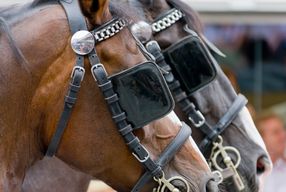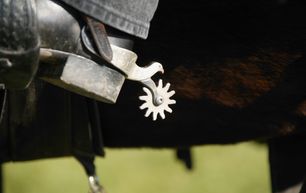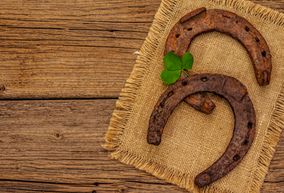The CLYDESDALE HORSE SOCIETY
SHOW AFFILIATION RULES & GUIDELINES - 2017
Show Societies affiliated to the Clydesdale Horse Society (CHS) should run their Clydesdale Classes in accordance with the Society’s rules and regulations.
The show should ensure that any CHS awards restricted to CHS members are presented to eligible exhibitors. If the show society has any doubt if the exhibitor is a member of the CHS it should ask for the exhibitor’s membership card or contact the CHS secretary.
Judges
The judge(s), wherever possible, should be selected from the CHS panels or be on the equivalent panel or a recognised judge in a foreign country.
Show Ring Etiquette
Exhibitors, handlers and their grooms must at all times present themselves in the show ring neatly and smartly dressed. For in-hand classes a white coat is recommended, with smart trousers or skirt with a shirt and tie. Appropriate foot wear should be worn.
Only two persons should be permitted in the show ring with each horse, namely the person leading the horse and one attendant for dressing out purposes. The attendant should also be smartly dressed.
CHS Awards
The Clydesdale Horse Society Shield
An engraved Shield is available for award at each affiliated show. This is to be awarded to the best yearling or two year old colt or filly (excluding Grade-ups and colts out of Grade-up Mares) registered or eligible for registration with the CHS exhibited by a current member of the CHS. A Rosette is also awarded. In its lifetime each animal may only win one Shield and so the judge must choose the best eligible animal from non-Shield winners.
Young Handlers Class
Young Handlers must be aged 12 to 16 on the day of the qualifying show. Handlers may compete in any number of Young Handlers classes in any year / qualifying period but they may only qualify once. If any handler placed in a class has already qualified in 2016 and up to 30 April 2017 (see below) then the qualifying place must go down the line to the first available non-qualifier.
The qualification for Young Handlers classes will now (effective 2016/2017) run between 1 May and ending on the following 30 April, thereby allowing young handlers to qualify at shows early in the year and to compete in the finals in the same year at the Royal Highland Show. As the first year in which this arrangement is to operate will be in the period ended 30 April 2017, for the 2017 finals it will be possible for shows held between 1 January and 30 April to have 2 qualifiers, one for the 2016 show and one for the 2017 show.
THE CLYDESDALE HORSE SOCIETY
SHOW AFFILIATION RULES & GUIDELINES - 2017
Young Handlers Class (continued)
Only animals that have already competed in the normal show or driving classes may be used. Entire colts are not allowed. Judging of this class is not to be on the merits of the animals – it is to be on the quality of the stockmanship and handling in the show ring by the young handler. Rosettes will be provided to all entrants by the CHS. Competitors should wear white coats, CHS ties and suitable footwear.
Please note that handlers may still compete in the final at the Royal Highland Show 2017 although they may be aged 17 by that point. The qualifying cut-off date is the actual day of the affiliated show.
It should also be made clear that there will be a very tight timescale at the end of the qualifying period to get entries into the Secretary to allow names to go forward to the Highland Show. People qualifying in the last week in April should contact the Secretary immediately following qualification.
Suggested Wording for your Schedule:
The Clydesdale Horse Society Shield
A Shield (which will be supplied and engraved by The Clydesdale Horse Society) will be awarded to the best yearling or two-year-old colt or filly, registered or eligible for registration with the Society, not having won a Shield before in its lifetime. The exhibitor must be a current member of The Clydesdale Horse Society.
Young Handlers Class
An engraved medal is presented by The Clydesdale Horse Society to the best young handler aged 12 to 16 on the day of the show who has not already qualified in 2016 and up to 30 April 2017. The capabilities of the handler are to be assessed, not the animal being led. The qualifier will be eligible to compete in the final at The Royal Highland Show in 2017.
The Young Handler Scheme and The Young Handler Final are generously sponsored by the James Bennett Fund.
Society Forms:
The show society should return all relevant forms as soon as possible after the show.
Ian A Roy
Secretary / Administrator
7 Turretbank Place
Crieff, PH7 4LS
Telephone: 07720 895870
RIDDEN CLASS GUIDELINES
Shows affiliated to the Clydesdale Horse Society should run their Clydesdale Classes in accordance with the society’s rules and regulations.
The judge(s), both ridden and conformation, wherever possible, should be selected from the Clydesdale Horse Society panel. In the event that it is not possible to select a ridden panel judge the society recommends that the Hunter, Working Hunter, Riding Horse or M&M ridden judge from the light horse section joins the in-hand judge for the judging of the ridden section of the class.
Horses should only be stripped and trotted up when there is a conformation and a ridden judge. Conformation and riding judging should take place simultaneously. In this situation the class should be judged using the Marks System, 50 marks are allocated for ride/manners and 50 for conformation / type. Where there is an equality of marks, the ride/manners marks take precedence over conformation.
Where there is a single judge, the ride/manners of the horse should take precedence over conformation, but conformation must be considered.
A judge must never judge any horse that is or has been owned, bred, produced, or exhibited by them.
If, in the opinion of the judge, a horse is unsound, the exhibitor shall be given the option of withdrawing the horse from the class or being placed at the bottom of the class.
The judge may require that a horse which constitutes a danger leaves the ring; the judge’s decision is final.
DRESS CODE FOR RIDERS
Turnout should be natural, traditional and smart, similar to that worn in a hunter or mountain moorland class.
It is recommended that riders of Clydesdale Horses wear tweed jackets, shirt and tie, cream or fawn breeches or jodhpurs. Plain long black or brown boots. (Juniors 16 and under may wear jodhpur boots.) Leather / string gloves.
Hair ribbons and bows kept to a minimum.
No ear rings, body studs or visible jewellery should be worn.
Must wear a hard hat - a skull cap or hat according to the current BSI or European Standard.
Whips/canes must not exceed an overall length of 76 cms (30 inches) and if they are misused, in the opinion of the judge, the rider may be sent out of the ring.
Spurs should not be worn.
Above all riders and their grooms must, at all times, present themselves in the show ring neatly and smartly dressed.
HORSES TURNOUT/SHOWING
Black or Brown tack, clean and well fitting.
Plain bridle with cavesson noseband and plain browband with a snaffle or traditional double / pelham riding bit. No bitless bridles or Liverpool bits.
English saddle with plain leather or webbing girth.
Numnahs to be discreet. No bright colours.
All ridden horses must be four years old or over.
Shoeing should be of a traditional nature and indicative of the nature of its use. If bevel shoes are worn screw in studs must be fitted.
Tail plait and wool and flights optional but for Health & Safety reasons no standing wired flights.
A fall of horse or rider in any class will result in disqualification. The rider must not remount in the ring.
At shows where there is not a ride judge a stand / individual show will be required. Riders will be required to give a short individual show at walk, trot & canter or set show lasting approximately 2 minutes. Change of rein and lengthened strides in canter at the judge’s discretion. Rein back, (optional) and halt.
At all times the rider must be courteous to others within the ring, leaving plenty of space for other horses. Where necessary riders should circle to create more space. The impression to aim for is good manners, smart, workmanlike, safe and comfortable.




